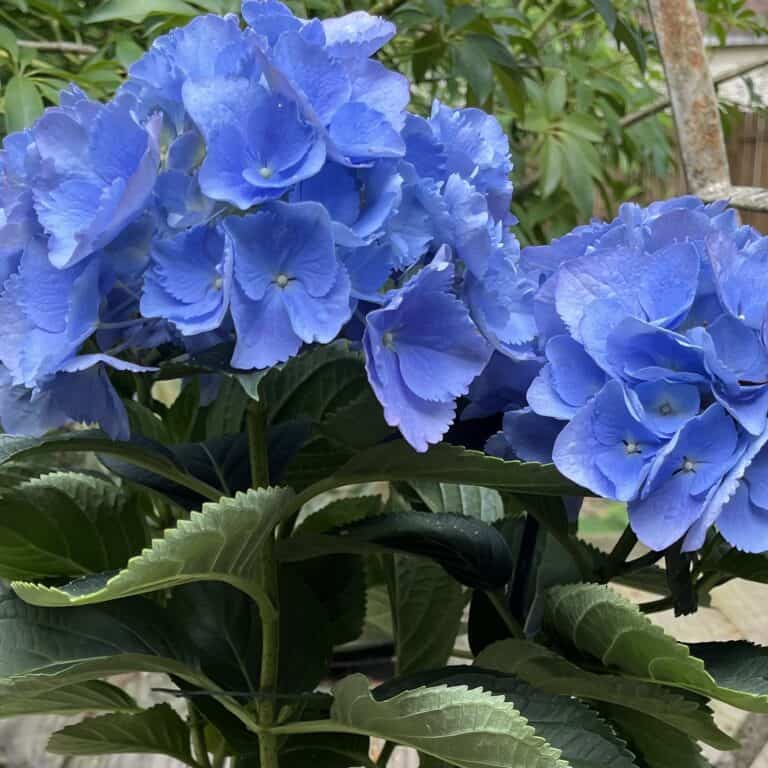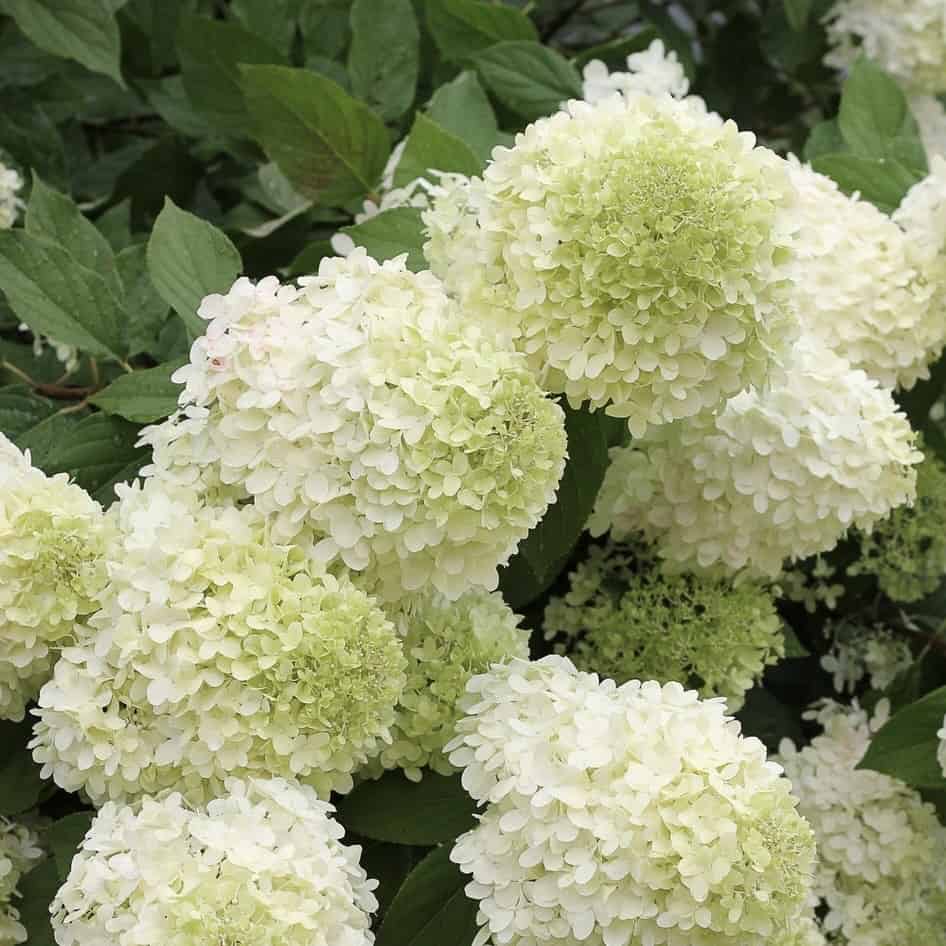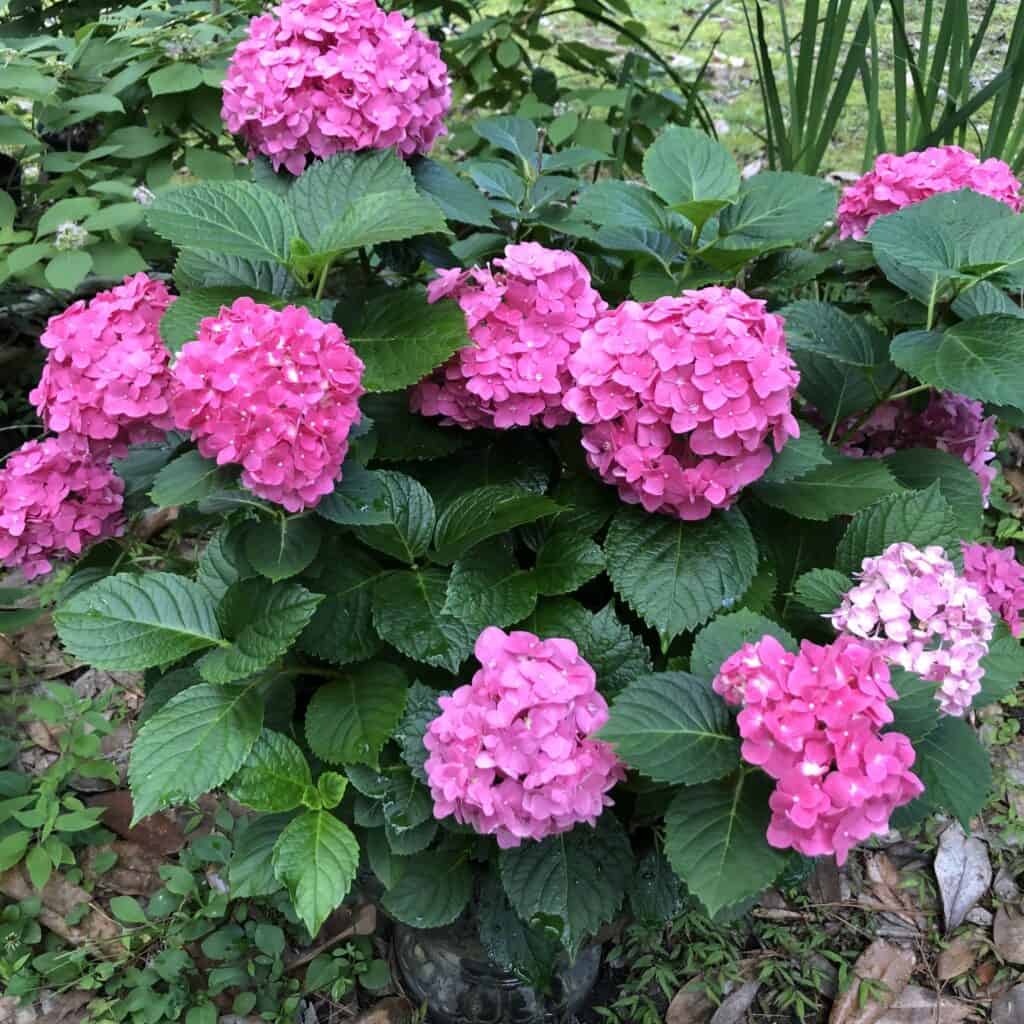For generations, hydrangeas have been favored by New Orleans gardeners for the magnificent blooms that create a focal point in our summer landscape. Today many new varieties exist that tolerate more sun and allow more flexibility in growing these deciduous shrubs. Here’s an overview of some popular hydrangeas.
Photo: ‘Penny Mac’ Hydrangea macrophylla by Karen Blackburn
Hydrangeas are beautiful shrubs which bloom from late April through July with huge flower
heads of light pink, pink, rosy-red, lavender, light blue, bluish purple, blends as well and white with rich green leaves. They are essential to the Southern Garden and put on a colorful show.
Garden hydrangeas (Hydrangea macrophylla) are native to Japan and are the most common type of hydrangeas grown in area gardens. Most garden hydrangeas set flower buds once in late summer around July in our climate. These flower buds stay dormant on the plant over winter and spring and bloom in May. After those flower buds bloom, the blooming season finishes. The bushes don’t typically bloom again until the next year. (Although after the buds are set in July, some of the heads may bloom in late summer, providing a few off-season flowers.)
Penny Mac (pictured above) was named a Louisiana Super Plant selection for spring 2012. The Penny Mac hydrangea is a vigorous, deciduous shrub that grows about 4 to 6 feet tall and about 3 to 4 feet wide. The foliage is medium green. The large flower heads are of the mophead type which is themost popular form of garden hydrangea. Penny Mac set buds differently. Instead of blooming just in May, they set and bloom flowers all though the summer. They still set buds in July that produce the main floral display in May the next year, but they also set buds on new shoots that produce flowers that same summer. These “remontant” or everblooming hydrangeas tend to produce more flowers in mid-to late summer than typical types.

Hydrangea macrophylla
Plant hydrangeas in a spot where they receive some shade during the day. They prefer morning sun, so an eastern exposure is excellent. Avoid hot, sunny, dry areas or beds that are baked by the afternoon sun. Add a 2-to-4-inch layer of organic matter, such as compost, rotted manure or peat moss into the soil during bed preparation. The organic matter helps the soil retain moisture yet makes sure that the soil stays loose and open, preventing it from getting waterlogged. (Hydrangeas may develop root rot in constantly soggy soil.) Once planted, water hydrangeas deeply and thoroughly twice a week while they get established their first summer. Water established shrubs once or twice a week if the weather is dry. Hydrangeas also benefit from a 2-inch-thick layer of mulch, such as leaves, pine straw or pine bark, to help maintain a moist soil.
The colorful parts of the flower head are not petals but modified sepals. The sepals start off
greenish when young, then gradually expand and take on color as the flowers get ready to open. The color of the sepals is influenced by the availability of aluminum ions in the soil where the plant is growing. In acid soils, free aluminum ions in the soil are absorbed by the plant and make the flower heads blue. In alkaline soils, aluminum ions are not available and flower heads tend to be pink. White hydrangeas do not have pigment in their sepals and are white regardless of the soil pH.
To make pink hydrangeas blue, treat the soil around the bushes with aluminum sulfate in March and again in October each year. If you want your blue hydrangeas to be pink, treat the soil around the bushes with lime following the same schedule. It may take a couple of years for the treatments to be fully effective. The intensity of the color (such as light pink, deep pink or rosy red) is controlled by genetics and depends on the variety you are growing. Eventually, though, the flowers begin to fade to a greenish color as they age, often with burgundy tints, in June or July.

Hydrangea quercifloria
When the flower heads turn green, it signals the ideal time to prune your plants. First, cut off the faded flower heads with stems about 4 to 6 inches long (these dry beautifully). To reduce the size of your bush, cut longer stems and shorten any other shoots as needed to achieve the desired results. This type of pruning should be done by mid-July. Do not prune hydrangeas in winter.
Oakleaf hydrangea, Hydrangea quercifolia, is indigenous to the southeastern United States. It grows in nature in mixed hardwood forests, along streams and on forested hillsides, usually on calcareous soils. Oakleaf hydrangea is an understory shrub, growing to 6 to 10 feet tall, the shrub has deeply lobed, oak-like, 8-inch leaves that turn reddish bronze in fall. The white-flowered panicles start opening in late April through early May in Louisiana and gradually turn pinkish as they age. Oakleaf Hydrangeas spread by stolons and can colonize an area. They grow best in well-drained soils containing plenty of organic matter with pH of 6.5-7.0. Place in about 5 hours of morning sun and cooler, afternoon shade for more flowering. with about five hours of direct sunlight in the morning. They are sensitive to saturated soils, and root rot is a common problem in Louisiana. It is caused by poorly drained soils and is common after significant rains. Consider planting Oakleaf Hydrangea in the fall.
Dr. Allen Owings recommends several oakleaf hydrangea varieties, including Alice, Snowflake and Ellen Huff. Alice produces creamy white, 10- to 14-inch flower clusters. It tolerates more sun and foliage turns burgundy red in fall. This selection is from the University of Georgia. Snowflake is special because of its double sepals that make blooms appear to be double. The florets continue to open throughout summer, giving this variety a longer bloom time than the single-sepal varieties. Plants can grow to be 8-10 feet tall. Ellen Huff is a strong grower for the Gulf Coast area. This variety has good heat tolerance on plants that reach 6-8 feet tall. New varieties from the US Department of Agriculture are, Queen of Hearts, Munchkin and Ruby Slippers.

Hydrangea paniculata
Limelight hydrangeas may be planted into beds, as individual plants or in containers. When
planted into beds, make sure the soil is well-prepared and the bed drains well (raised beds work well). Incorporate 2 to 4 inches of compost into the upper 8 to 10 inches of soil before planting. Make sure the top of the root ball is level with or slightly above the top of the soil in the bed. Dig a hole as deep as the root ball and three times the diameter. Remove the plant from the container, place it in the hole. Add a generous amount of compost to the soil removed from the hole and blend them together. Use this to fill around the Limelight hydrangea. Water it in thoroughly and mulch the area. If planting in a container, choose a large container of around 10 gallons and pot the plant using a good-quality potting mix.
Limelight hydrangeas are not as fussy as garden hydrangeas about watering. Water deeply once or twice a week during hot, dry summer weather or when you see the shrubs wilt slightly. Do not over water as root rot is caused by watering too frequently after planting. Allow the soil to dry somewhat between irrigation.
Limelight and other panicle hydrangeas bloom later than the garden hydrangeas. Limelight
begins to bloom in late May or June. The cone-shaped flower heads are large and showy. The color starts off a shade of light sage like green, matures to creamy white and ages to a shade of rose in late summer or fall. White is the only color this species blooms in, although they age to shades of pink to a rosy red produced when the flowers age adds a whole new dimension. Flowers stay attractive for months as they gradually age. Limelight flowers are spectacular when cut for indoor arrangements. Hang and dried as you would garden hydrangeas. Prune Limelight hydrangeas during late winter or early spring they blooms on new growth. Plants are shapelier and bloom better if pruned back by about one-third
in February or March.
Information for this article from articles by Dr. Allen Owings retired, Horticulturist, research, Hammond Research Center and from articles by Dan Gill, retired Consumer Horticulturist, LSU AgCenter.

Karen Blackburn
Master Gardener of Greater New Orleans

